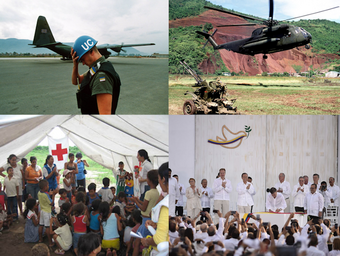Chaibian War: Difference between revisions
Jump to navigation
Jump to search
mNo edit summary |
mNo edit summary |
||
| Line 5: | Line 5: | ||
|date= 2 January 1982 – present<br />({{Age in years, months, weeks and days|month1=01|day1=02|year1=1982}}) | |date= 2 January 1982 – present<br />({{Age in years, months, weeks and days|month1=01|day1=02|year1=1982}}) | ||
|partof= the [[Atomic Age (Teleon)|Atomic Age]] (1945–present) | |partof= the [[Atomic Age (Teleon)|Atomic Age]] (1945–present) | ||
|image = | |image = Chaibian War collage.png | ||
|image_size = | |image_size = 340px | ||
|caption = | |caption = '''Clockwise from top left:''' A [[Falland|Fallish]] [[United Congress (Teleon)|UC peacekeeper]] during [[United Congress Observer Mission in Nadauro|UCOMCA]] involvement in the [[Battle of Caridoso]] in 1989, a Nadauran military helicopter hovers over an abandoned FLP {{wp|anti-aircraft weapon}} in 1987, the [[Easter Agreement (Nadauro)|Easter Agreement]] is signed by [[President of Nadauro|President]] [[Tadeu Espíndola]] in 1990, {{wp|internally displaced people}} in [[Itzalcoatl]] | ||
|place= [[Nadauro]], with spillover into [[X]] | |place= [[Nadauro]], with spillover into [[X]] | ||
|status= Ongoing, [[Nadauran peace process]] | |status= Ongoing, [[Nadauran peace process]] | ||
Revision as of 12:48, 21 August 2024
This article is incomplete because it is pending further input from participants, or it is a work-in-progress by one author. Please comment on this article's talk page to share your input, comments and questions. Note: To contribute to this article, you may need to seek help from the author(s) of this page. |
| Chaibian War | ||||||||
|---|---|---|---|---|---|---|---|---|
| Part of the Atomic Age (1945–present) | ||||||||
 Clockwise from top left: A Fallish UC peacekeeper during UCOMCA involvement in the Battle of Caridoso in 1989, a Nadauran military helicopter hovers over an abandoned FLP anti-aircraft weapon in 1987, the Easter Agreement is signed by President Tadeu Espíndola in 1990, internally displaced people in Itzalcoatl | ||||||||
| ||||||||
| Belligerents | ||||||||
|
Supported by: |
Nadauran drug cartels and right-wing paramilitaries
Supported by: X |
Nadauran guerrillas
Supported by: X | ||||||
| Commanders and leaders | ||||||||
|
| ||||||||
| Strength | ||||||||
|
Ground Self-Defense Force: 177,400 Naval Self-Defense Force: 47,250 Air Self-Defense Force: 33,350 National Police: 267,560 |
Paramilitary and successor groups: 4,500–26,000 CLUN: 40,200 |
FLP: 34,000 (2015) ER1M: 13,890 (2006) MAR: 1,200 (1990) | ||||||
| Casualties and losses | ||||||||
|
19,840 injured (1982–1990) |
39,000 demobilized 1,740 captured Armala cartel: 3,400 killed |
22,000 demobilized (since 2016) 900 captured (since 1985) 4,000 captured (since 1990) | ||||||
|
Civilians killed: 164,427 Individuals abducted: 25,027 Total number of individuals displaced: 3,363,000–5,100,000 Total number of refugees: 100,000+ | ||||||||
The Chaibian War (Lavish: Guerra do Chaibia), also referred to as the Nadauran War (Lavish: Guerra do Anadaúro) and commonly as A Violência (lit. "The Violence"), was a low-intensity conflict dominated by asymmetric warfare throughout the 1980s between the federal government of Nadauro and the state government of Chaibia, far-right paramilitary groups, drug cartels, and far-left guerrilla groups, following the collapse of the Caravelas regime and the Third Empire of Nadauro in 1979.
TBD

